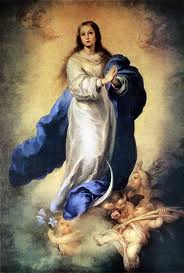
The Feast of the Immaculate Conception
The Feast of the Immaculate Conception celebrates belief in the Immaculate Conception of the Blessed Virgin Mary. It is celebrated on 8 December, nine months before the Nativity of Mary, which is celebrated on 8 September. It is the patronal feast day of the United States. It is celebrated by the Roman Catholic Church as well as a few other closely related Christian Churches.
HISTORY
The Eastern Christian Church first celebrated a feast of the Conception of the Most Holy and All Pure Mother of God on December 9th perhaps as early as the 5th century in Syria. By the 7th century it was widely known feast in the East. In the same century the doctrine of Mary’s spotlessness was included in the Koran. However, when the Eastern Church called Mary achrantos (spotless or immaculate), it did not define exactly what this meant. Today the majority of Orthodox Christians would not accept the Scholastic definition of Mary’s preservation from original sin before her birth that subsequently evolved in the Western Church after the Great Schism of 1054. After the feast was translated to the Western Church in the eighth century, it began to be celebrated on December 8th. It spread from the Byzantine area of Southern Italy to Normandy during the period of Norman dominance over southern Italy. From there it spread into England, France, Germany, and eventually Rome.
Prior to Pope Pius IX's definition of the Immaculate Conception as a Roman Catholic dogma in 1854, most missals referred to it as the Feast of the Conception of the Blessed Virgin Mary. The festal texts of this period focused more on the action of her conception than on the theological question of her preservation from original sin. A missal published in England in 1806 indicates the same collect for the feast of the Nativity of the Blessed Virgin Mary was used for this feast as well.
The first move towards describing Mary's conception as "immaculate" came in the eleventh century. In the fifteenth century Pope Sixtus IV, while promoting the festival, explicitly tolerated those who promoted it as the Immaculate Conception and those who challenged such a description, a position later endorsed by the Council of Trent.
The proper for the feast of the Conception of the Blessed Virgin Mary in the Medieval Sarum Missal, perhaps the most famous in England, merely addresses the action of her conception.
The collect for the feast reads:
In 1854, Pius IX made the infallible statement Ineffabilis Deus: "The most Blessed Virgin Mary, in the first instant of her conception, by a singular grace and privilege granted by almighty God, in view of the merits of Jesus Christ, the saviour of the human race, was preserved free from all stain of original sin."O God, mercifully hear the supplication of thy servants who are assembled together on the Conception of the Virgin Mother of God, may at her intercession be delivered by Thee from dangers which beset us.
CULTURAL IMPACT of the Feast of the Immaculate Conception
It is a public holiday in Poland, Andorra, Argentina, Austria, Chile, Colombia, East Timor, Equatorial Guinea, Italy, Liechtenstein, Macau, Malta, Monaco, Nicaragua, Paraguay, Peru, Portugal, San Marino, Seychelles, Spain, Vatican City Venezuela, and in the Catholic Cantons of Switzerland In some countries, though December 8 is not a public holiday, their respective Episcopal Conference however declared this day as a Holy Day of Obligation, as it is in the United States, the Philippines and Ireland.
The Feast of the Immaculate Conception is also the patronal feast day of the United States.
December 8 is also celebrated as Mother's Day in Panama honor of this holiday and is therefore a national holiday.
The University of Dayton celebrates Christmas on Campus every December 8 in conjunction with the Feast of the Immaculate Conception.
IMMACULATE CONCEPTION
The Immaculate Conception of Mary is, according to Catholic doctrine, the conception of the VIRGIN MARY without any stain ("immacula" in Latin) of original sin. It is one of the four dogmas in Roman Catholic Mariology. Under this aspect Mary is sometimes called the Immaculata (the Immaculate One), particularly in artistic contexts.
The doctrine states that, from the first moment of her existence, Mary was preserved by God from Original sin and filled with sanctifying grace that would normally come with baptism after birth. Catholics believe Mary "was free from any personal or hereditary sin". Mary's immaculate conception should not be confused with the Incarnation of her son JESUS CHRIST. Catholics do not believe that Mary, herself, was the product of a Virgin Birth.
The Feat of the Immaculate Conception, celebrated on 8 December, was established as in 1476 by Pope Sixtus IV. He did not define the doctrine as a dogma, thus leaving Roman Catholics free to believe in it or not without being accused of heresy; this freedom was reiterated by the Council of Trent. The existence of the feast was a strong indication of the Church's belief in the Immaculate Conception, even before its 19th century definition as a dogma.
The Immaculate Conception was solemnly defined as dogma by Pope Pius IX in his constitution Ineffabilis Deus 8 December 1854. The Catholic Church teaches that the dogma is supported by Scripture (e.g., Mary's being greeted by the Angel Gabriel as "full of grace") as well as either directly or indirectly by the writings of Church Fathers such as Iranaeus of Lyons and Ambrose of Milan. Catholic theology maintains that since Jesus became incarnate of the Virgin Mary, it was fitting that she be completely free of sin for expressing her fiat. In 1904 Pope Saint Pius X also addressed the issue in his Marian encyclical Ad Diem Illum on the Immaculate Conception.
In the Catholic Church the Solemnity of the Immaculate Conception is a Holy Day of Obligation and is widely celebrated including by the popes.